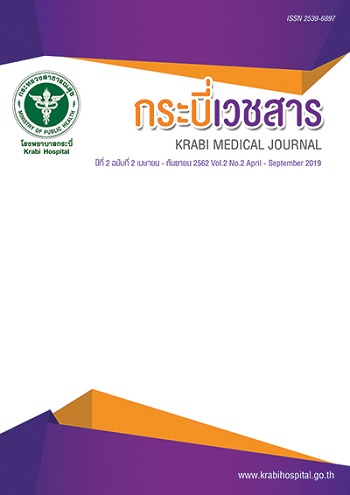Competency in DHF Control of Muang Krabi Surveillance and Rapid Response Team (SRRT): a Case Study of Muang Krabi
Main Article Content
Abstract
The purposes of this survey research were to study 1) the level of potential for prevention and control of dengue hemorrhagic fever (DHF) of Muang Krabi surveillance and rapid response team (SRRT), 2) individual characteristics of Muang Krabi SRRT, 3) factors in the process of managing, preventing and controlling of Muang Krabi SRRT and 4) factors related to the prevention and control of DHF of Muang Krabi SRRT.
The study was conducted among all 47 core members of SRRTs in district level and sub-district level in Muang Krabi. Data were collected using a questionnaire and then analyzed to determine frequency, percentage, mean and standard deviation as well as chi-square.
The findings revealed that: 1) among the respondents, they were mostly female (nearly 70%) and 45 years of age on average, and has experience in the SRRT, 2) their ages, educations, roles in the SRRT and experiences were associated with the DHF prevention and control operation, 3)DHF prevention and control
potential of SRRT in a high level average 3.97 (SD= 0.059) and 4) management factors involving manpower,
finance, planning, organizing, personnel management, directing and control were associated with the DHF
prevention and control operations.
It is suggested that relevant administrators should provide SRRT members with new knowledge about
DHF prevention and control, especially during the transfer of duties, allocate sufficient resources on a timely
basis, and facilitate public participation in these efforts.
Article Details
บทความนิพนธ์ต้นฉบับจะต้องผ่านการพิจารณาโดยผู้ทรงคุณวุฒิที่เชี่ยวชาญอย่างน้อย 2 ท่าน แบบผู้ทรงคุณวุฒิ และผู้แต่งไม่ทราบชื่อกันและกัน (double-blind review) และการตีพิมพ์บทความซ้ำต้องได้รับการอนุญาตจากกองบรรณาธิการเป็นลายลักษณ์อักษร
ลิขสิทธิ์
ห้ามนำข้อความทั้งหมดหรือบางส่วนไปพิมพ์ เว้นว่าได้รับอนุญาตจากโรงพยาบาลเป็นลายลักษณ์อักษร
ความรับผิดชอบ
เนื้อหาต้นฉบับที่ปรากฏในวารสารเป็นความรับผิดชอบของผู้เขียน ทั้งนี้ไม่รวมความผิดพลาดอันเกิดจากเทคนิคการพิมพ์


